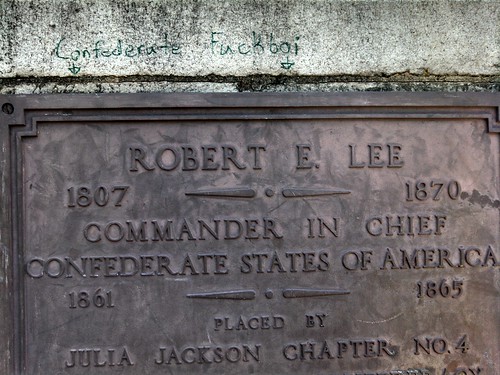
Where has the year gone? We're almost all the way to the end of Everybody Shout At The Mayor Season. The final Budget Circus Shout Session is next Monday in District E. If that seems early to you, it's because it is. Shouting at the mayor season was intentionally moved up the calendar this year in order to better serve the illusion that the shouting actually helps to shape the mayor's budget priorities. It doesn't. But, man, is it ever fun.
Still, the shift in schedule may have caused you to miss your chance to get in on the excitement. If so, you are in luck.
Following last week's invite-only daylong discussion on the future of the city's Confederate landmarks, the City of New Orleans hosts two meetings next week that are open to the public.Oh boy. Do you think they know what it is they are asking for?
The Historic District Landmarks Commission hosts a meeting in City Council chambers at City Hall (1300 Perdido St.) from 1 p.m.-3 p.m. Thursday, Aug. 13, followed by a Human Relations Commission meeting at 6 p.m.
Up for discussion are the possible relocations of several monuments to the confederacy, including a statue of Robert E. Lee at Lee Circle, a Jefferson Davis statue on Jefferson Davis Parkway, a P.G.T. Beauregard statue in front of City Park, and the Liberty Place Monument on Iberville Street.
According to a release, comment cards at the Human Relations Commission meeting must be submitted no later than 7 p.m. in order for participants to speak. The city also is accepting public comments online at www.nola.gov/hdlc or www.nola.gov/hrc. Those comments must be received by 5 p.m. Tuesday, Aug. 11 to be entered into the recordHa ha, yes they do, indeed. Well, okay, let's have it out. This will only take about all of the rest of our lives to resolve. Not that it should take that long. As I and others have said, this isn't as complicated as the reactionaries are making it out to be. The specific monuments in question represent a propaganda campaign on the part of Confederate apologists during the Jim Crow period. It is time to end that campaign. We've spent enough time trying to annotate or compromise with it to know that isn't going to work.
For example, this is the Liberty Place monument.
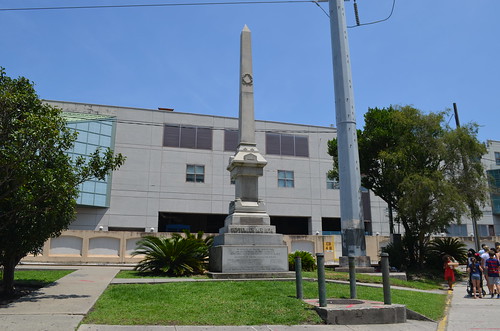
Erected in 1891, it commemorates the restoration of white supremacist government to Louisiana by purposefully misrepresenting a riot during which members of the Crescent City White League murdered Metropolitan Police and state militia as a "battle" for "Liberty." Inscriptions added later celebrated the end of reconstruction declaring, "The national election of November 1876 recognized white supremacy in the South and gave us our state."
In the 1970s another inscription was added saying, basically, "Hey we don't actually think the racist stuff we wrote on this monument before." More controversy ensued.
This gesture satisfied almost no one. In 1976, the NAACP Youth Council requested the monument's removal, while some decried the plaque as "historical revisionism." Furthermore, modern white supremacist groups such as the Ku Klux Klan began to see the memorial as a rallying point for planned marches and demonstrations.When they put it back they, somewhat clumsily, patched over the white supremacy inscription with this piece of marble.
In 1981, the monument nearly left public view at Mayor Ernest "Dutch" Morial's order, sparking a new round of public discussion and protest. Ultimately, the City Council blocked any move or alteration, and the monument remained on Canal Street, although partially hidden behind tall bushes.
The monument left public view in 1989, reportedly for safe keeping, amidst construction on Canal Street. Mayor Sidney Barthelemy pledged to return the marker, though his administration missed the originally stated date for its replacement. The structure stayed in storage until February 1993, when a movement led by David Duke, a former Grand Wizard of the Ku Klux Klan, sued for its return. To the chagrin of many residents, the city obliged but moved the obelisk off of Canal Street to its present site in the curve of Iberville Street, between railroad tracks and the entrance to a parking garage.
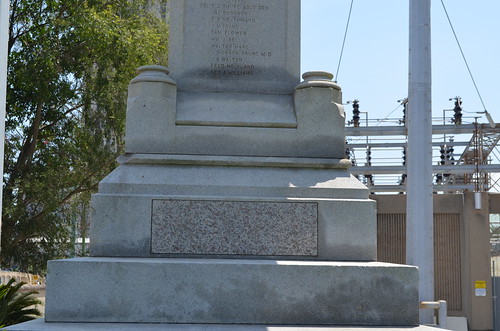
They also added a new front panel with some words about how we really need to honor "both sides" of the riot incited by the White Leaguers because doing so will "teach us lessons for the future."
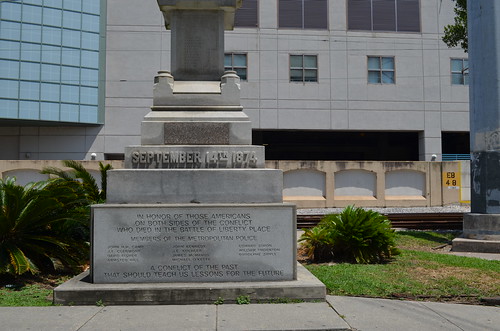
I'll be the first to admit that this thoroughly stupid collection of insults and exacerbating half-remedies is full of historical significance. It should be preserved somewhere. But let's not allow it to continue on public display as a monument. There's nothing we can do to make it appropriate for that. And clearly we have tried.
The mayor wants us to consider renaming Jefferson Davis Parkway. I'm open to that, although I'm not thrilled that he wants to rename it for Norman Francis. But the monuments on the neutral ground are the real problem. Like this one to Colonel Charles Didier Dreux
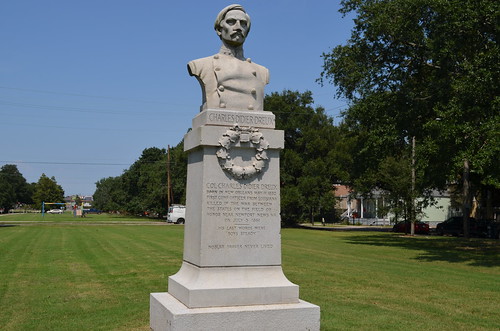
That one along with other monuments described in this article to "Poet Priest of the Confederacy" Abram J Ryan, General Albert Pike, and, of course, JD himself make the entire length of the street into a Confederate theme park.
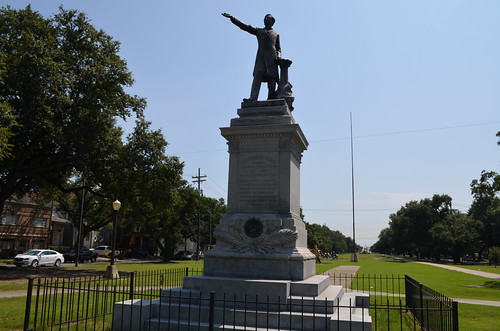
It's probably well past time for us to change that. But, if last week's District A Budget meeting is any indication, that will not be easy.
Landrieu: "It does not surprise me that some folks in this room may not feel and may not think that some people in this city are offended every time they drive by a statue that they think reveres—" "History!" one woman yells. Landrieu politely asks her to let him finish.One wonders, though, why the cries of "History!" are loudest in defense of these Jim Crow era revisionist monuments. If it's important that we ensure the memory of our city's Old South history remain at the forefront of public consciousness, why not consider the far more significant sites and events we are currently neglecting?
Here is a view of the intersection of St. Louis and Charters Streets in the French Quarter.
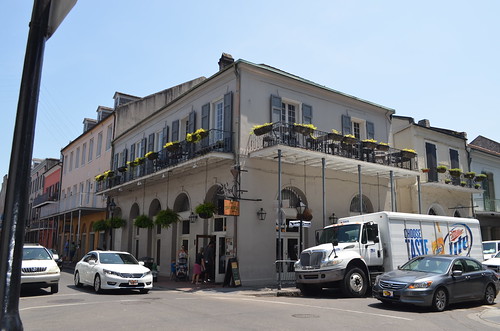
The building we're looking at in the photo is a horrendous tourist trap of a "Cajun restaurant" called Original Pierre Maspero's (est. 1788). According to an official enough looking plaque on the wall there, this was the site where Andrew Jackson met with the famous Lafitte brothers to plan the defense of New Orleans from the British. Oh and also, the plaque says matter of factly, "slaves were sold there."
The first problem for fans of History! is none of that is true. None of it is true of that building, anyway. The building that was once known as Maspero's Exchange (but also under other names) and where at least some of those things happened no longer exists. It was located across the street. On the corner from where this photo was taken, actually. Richard Campanella describes it here.
Originally called Tremoulet’s Commercial (or New Exchange) Coffee House, this business became Maspero’s Exchange in 1814, Elkin’s Exchange after Pierre Maspero’s death in 1822, and by 1826, Hewlett’s Exchange, named for new owner John Hewlett. Because of the place’s popularity and frequent management changes, newspapers and city directories ascribed a variety of names to the business at 129 (now 501) Chartres: the “Exchange Coffee House,” “New Exchange Coffee House,” “Hewlett’s Coffee House,” or “La Bourse de Hewlett.”Which brings us to another point of interest our History! buffs might want to have a look at. The stuff in the plaque about Andrew Jackson and the Lafittes is shaky. But the "slaves were sold there" bit is quite an understatement. Campanella only talks about the Exchange's importance to "the New Orleans business community." But this may be selling the scene short. In fact this was the center of the American trade in cotton and in human beings.Which is to say it was a major nexus of 19th Century global capitalism.
The two story, 55-by-62-foot edifice boasted behind its gaudy Venetian screens a 19-foot-high ceiling, four 12 lamp glass chandeliers, framed maps and oil paintings (described by one Northerner as “licentious”), wood and marble finishing, and an enormous bar with French glassware. Like many of New Orleans’ coffee houses, the upper floor contained billiards and gambling tables. Throughout the mid-antebellum years, Hewlett’s Exchange buzzed with trilingual auctioning activity, in which everything from ships to houses to land to sugar kettles to people legally changed hands.
The city’s seven auctioneers worked the block on a rotating schedule, every day except Sunday, oftentimes while maintaining other jobs elsewhere. Joseph Le Carpentier handled Mondays, Wednesdays, and Saturdays; Toussaint Mossy (president of the New Orleans Architect Company) worked Tuesdays and Fridays; H. J. Domingon, George Boyd, and Joseph Baudue got Tuesdays, Thursdays, and Saturdays; and the busy Isaac McCoy and Francois Dutillet worked six days a week. At the time of Lincoln’s visit, Hewlett’s Exchange was the New Orleans business community’s single most important public meeting site for networking, news-gathering, and wheeling-dealing.
A recently published book to read here is by historian Edward Baptist. An early chapter in The Half Has Never Been Told: Slavery and the Making of American Capitalism describes innovations in banking and credit that allowed great fortunes in commodities and slaves (who were themselves commodities) to be moved great distances at the stroke of a pen. "Innovators" like New Orleans businessman Vincent Nolte could write an order from a table at Maspero's Exchange and thousands of bales would be headed to Liverpool, or thousands of slaves shuffled off from Maryland to Alabama. Baptist calls this the entrepreneur's "right hand" power. Today we might recognize it as "disruption." (You might have to click the image to read the quote.)
Given the modern enthusiasm for wave after wave of "creative destruction" heralded at every NOLA Entrepreneur Week, you'd think our History! buffs would be thrilled to know more about the dynamic 'treps like Nolte who hung around in hip bars like Maspero's thinking up how to do Uber but for slavery.
But for some reason, they'd rather fixate on preserving the over-embellished memories of a failed rebellion bent on preserving the slave power these entrepreneurs created. Maybe they just prefer losers. Or maybe they don't have any idea what they're talking about. In any case, they're sure to be yelling about it at City Hall next week. If you have the opportunity to witness this historic event, please take notes. Otherwise someone may call it a "battle" and try to commission a monument.

No comments:
Post a Comment